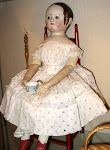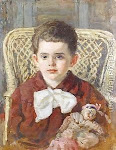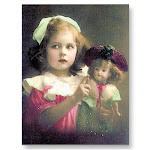
Mary Ann (nee Todd) Lincoln (December 13, 1818 – July 16, 1882)
Mary was the fourth of seven children, and her mother died after giving birth to her seventh child when Mary was six years old. A year and a half later, her father remarried and this marriage brought nine more children into the house. Mary’s stepmother was not sympathetic towards Mary which, some historians comment, might have contributed to her insecurities later in life. Despite growing up in the south with household slaves, Mary very early on grew to abhor slavery.

Mary Todd left home at an early age to attend a fine school. By the age of 20 she had a sparking personality that made her quite popular among Springfield's gentry. When she began living with her sister Elizabeth’s family, whom were very socially prominent, Mary became a popular belle.

Just 5 feet 2 inches at maturity, Mary had clear blue eyes, long lashes, light-brown hair with glints of bronze, and a lovely complexion. She danced gracefully, she loved finery, and her crisp intelligence polished the wiles of a Southern coquette.
*************************************************************
In the fall, she met Abraham Lincoln, an aspiring lawyer who was 10 years her senior . They fell in love and were engaged at the end of the following year. Perhaps with his poorer background and debt in mind, Abraham asked Mary to release him from the engagement. After much depression, a friend arranged for them to get together again. The wedding took place on November 4, 1842,. Inside Mary’s ring was the inscription “Love Is Eternal.”


Mary Todd Lincoln's Inaugurational Gown

First Ladies of the White House Exhibit

They had four sons: Robert Todd (August 1, 1843), Edward Baker (March 10, 1846), William Wallace (December 21, 1850), and Thomas “Tad” (April 4, 1853). Eddie died of diphtheria. He was not even four years old. Afterwards, Mary could not speak his name without crying.


Thomas "Tad" Lincoln (April 4, 1853 – July 15, 1871) was the fourth and youngest son of 16th United States President Abraham Lincoln and Mary Todd Lincoln. Tad was known for his antics around the White House. There are stories of him interrupting Presidential meetings, drilling the White House guard and charging visitors to see his father.

Kiowa and Cheyenne leaders pose in the White House conservatory with Mary Todd Lincoln (standing far right) on March 27, 1863, during meetings with President Abraham Lincoln, who hoped to prevent their lending aid to Confederate forces. The two Cheyenne chiefs seated at the left front, War Bonnet and Standing In the Water, would be killed the next year in the Sand Creek Massacre.

Abraham was soon elected to the House of Representatives and in 1860, the year Republican party nominated him for president. the Civil War was imminent.

Doll is reproduction Mary Todd Lincoln (kit) sold by Yield House in 1970's.

Possibly Conta Boehme ca. 1860's

Southerners felt Mary was a traitor, turning against her roots, while Northerners felt she was a spy, as many of her relatives sided with the Confederacy. Mary Lincoln suffered from severe headaches throughout her adult life, and as First Lady had to deal with the death, from a fever, of her son Willie, as well as the deaths of siblings killed in the Civil War. Difficult bouts of mourning, especially after Willie’s death, led to protracted depression.


Black Velvet 1861...This dress depicts authentic period fashion of 1861. It features a high bodice with a front closure with open bell-shaped pagoda sleeves lined with white fabric and trimmed with ruching. The entire gown is lined with a sheer black cotton. The collar is white lace, fastened with a pearl broach. To accessorize the outfit, there is a handkerchief, fan, matching earrings and head dress. The fabric is authentic 1800's black cotton velvet.

Alt, Beck and Gottschalk "Mary Todd"...White glazed china shoulder-head with painted black hair, and two gilded hair bows. Body completely made of cloth ca. 1865


The president “had all her love,” and Lincoln loved her “as only his mighty heart could.”
Charles Sumner senator from Massachussetts.
“My wife was as handsome as when she was a girl,” Lincoln once told a reporter. “And I, poor nobody then, fell in love with her, and what is more, have never fallen out.”

Exquisite Conta Boehme "Mary Todd" shoulder head ca. 1866

The Young Mr. and Mrs. Lincoln

Once when Mary Lincoln let loose her anger at her husband’s arriving late for supper, he simply scooped her up in his arms and kissed her.


Mary Todd was vivacious and impulsive, with an interesting personality--but "she now and then could not restrain a witty, sarcastic speech that cut deeper than she intended...." A young lawyer summed her up in 1840: "the very creature of excitement." All of these attributes marked her life, bringing her both happiness and tragedy.

The 1860 decade marked the introduction of a number of china shoulder head dolls well known to collectors. One of them is the so-called Mary Todd Lincoln...There are no known pictures of Mrs Lincoln wearing the hairstyle credited to her by doll collectors. But she was prominent during the decade because of her husban's role as President of the United States during the Civil War.


Abraham Lincoln Presidential Library Exhibit "What They Were Wearing in Washington "
She has often been blamed for spending too much on the White House, but she felt, in defense of her drastic overspending, that it was important to the maintenance of prestige of the Presidency and the Union.


On April 9, 1865, with General Robert E. Lee surrendering to General Ulysses S. Grant, the war was officially over. Just five days later, on April 14, Abraham was shot by John Wilkes Booth in the Ford Theater, Mary’s hand in his. The president lingered until passing away at 7:22 a.m. He was buried in Springfield, next to his two sons. Mary never recovered from this tragedy.

Museum piece Mary Todd Lincoln doll in mourning dress.


son..Robert Todd by Daniel Huntington ca. 1885
On May 22, 1865, she left the White House, to live with her remaining sons Robert and Tad. Unfortunately, Tad fell ill and never fully recovered from a respiratory infection. On July 15, 1871, he died. Mary had now lost her husband, three half-brothers, and three sons. “One by one,” she said, “I have consigned to their resting place my idolized ones, and now, in this world there is nothing left for me but the deepest anguish and desolation.” After Tad died , she slipped into a world of illusion where poverty and murder pursued her.


Her health deteriorated rapidly, and on May 20, 1875, after a juried trial, Mary was declared insane and confined to Bellevue Nursing and Rest Home in Batavia, Illinois. Mary’s supporters believed her son Robert had ulterior motives and they worked to get her released. A misunderstood and tragic figure, she passed away in 1882 at her sister's home in Springfield--the same house from which she had walked as the bride of Abraham Lincoln, 40 years before. She was buried next to her husband and three sons at Oak Ridge Cemetery in Springfield. Her wedding ring, thin from wear, still bore the words “Love Is Eternal.”


 Her wedding dress, a beautiful throw back to the fifties, brought back memories of Grace Kelly's wedding to the Prince of Monaco.
Her wedding dress, a beautiful throw back to the fifties, brought back memories of Grace Kelly's wedding to the Prince of Monaco.












































.jpg)

























































































































